|
August 2003
|
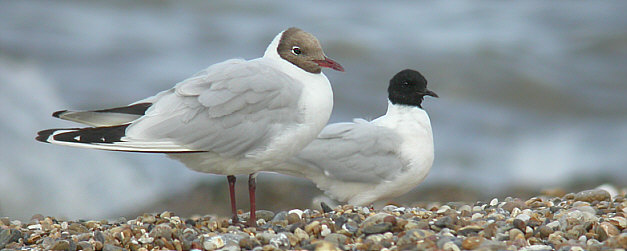 |
|
Black-headed and Little Gull - Lowestoft North Beach - ©Robert
Wilton
|
GREAT CRESTED GREBE Podiceps cristatus
Kessingland - 20th (2 N), 31st (1 N).
Ness Point - 21st (1 S), 28th (1 N).
FULMAR Fulmarus glacialis
Kessingland - 1st (1 S), 2nd (2 N, 1 S), 3rd (1 N), 4th (3 N),
5th (2 S, 1 N), 6th (3 N), 7th (4 N), 8th (2 N), 9th (1 N, 2 S), 10th
(2 N), 11th (5 N), 12th (4 N), 13th (4 N), 14th (1 N), 15th (9 N, 1
S), 16th (6 N), 17th (10 N), 18th (3 N, 1 S), 19th (5 N), 20th (3 S),
21st (5 N), 22nd (2 N, 1 S), 23rd (6 N), 24th (2 N), 25th (8 N), 26th
(4 N), 27th (11 N, 2 S), 28th (6 N, 1 S), 29th (2 N), 30th (5 N, 1 S),
31st (14 N, 1 S).
Ness Point - 2nd (1 N, 1 S), 7th (1 N), 13th (1 N), 16th
(1 N), 18th (2 N, 1 S), 20th (1 N), 23rd (1 N), 25th (7 N, 3 S), 26th
(65 N), 27th (61 N), 28th (16 N, 2 S), 29th (20 N, 2 S), 30th (7 N),
31st (5 N, 1 S).
Corton - 14th (2 N), 23rd (1 N), 27th (2 N), 28th (2 N).
CORY'S
SHEARWATER Calonectris diomedea
Ah, the beauty of mobile phones, hey! Following a tip-off one of
these magnificent birds was watched flying north past Kessingland at
12:53 on the 17th approximately 1.5km offshore to the jubilation of
the observer!!! Earlier two were watched heading north past Aldeburgh.
Another flew past Ness Point on the 28th to the elation of the three
observers. That's the last time one observer decides to stay in bed
until 11:00 again, damn it!!!!!!!
MANX SHEARWATER Puffinus puffinus
A rather lean month with far greater numbers of Sooties:
Kessingland: 30th (2 N @ 17:00), 31st 1 N @ 16:12).
Ness Point: 28th (4 N together).
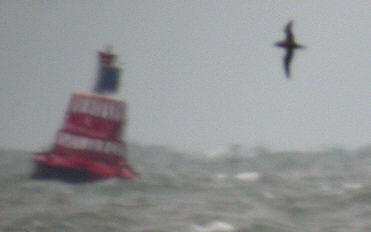 |
|
Sooty
Shearwater - Ness Point - August 25th, 2003 - ©Tim Brown |
SOOTY SHEARWATER Puffinus griseus
Kessingland - 15th (2 N, 09:48 and 17:03), 18th (1
N @ 06:50), 19th (1 N @ 9:55), 24th (3 N @ 09:10, 10:27 and 14:52),
25th (1 N @ 14:12), 27th (1 N @ 09:45), 28th (1 N @ 17:45), 29th (1
N @ 09:53), 30th (2 N @ 09:12), 31st (1 N @ 07:20).
Ness Point - 17th (1 N), 18th (1 N), 24th (3 N), 25th
(1 N), 30th (9 N), 31st (2 N).
Corton - 15th (1 N at 10:10 presumably same as at Kessingland),
27th (1 N), 28th (1 N @ 15:05).
STORM PETREL Hydrobates pelagicus
As the news broke about the Aldeburgh Cory's Shearwater's on the 17th
one observer at Ness Point panned south in anticipation. The Cory's
proved elusive. However a Storm Petrel jinking its way north at mid-day
was ample compensation. How many of these little characters 'skip' past
Lowestoft undetected? Let's just hope this wasn't the first and last
of the year!!!
GANNET Morus bassanus
Kessingland - 1st (2 N, 4 S), 2nd (130 N, 7 S), 3rd (52 N)
4th (52 N, 4 S), 5th (63 N), 6th (94 N, 2 S), 7th (38 N), 8th (36 N),
9th (in 1hr 40mins seawatching in very poor visibility no Gannets were
recorded), 10th (19 N), 11th (6 N), 12th (5 N), 13th (13 N), 14th (2
N), 15th (12 N), 16th (11 N), 17th (72 N, 5 S), 18th (69 N, 1 S), 19th
(28 N, 3 S), 20th (72 N), 21st (74 N, 2 S), 22nd (96 N, 2 S), 23rd (36
N, 2 S), 24th (116 N, 1 S), 25th (32 N), 26th (65 N), 27th (61 N), 28th
(16 N, 2 S), 29th (20 N, 2 S), 30th (21 N, 4 S), 31st (34 N, 5 S).
Ness Point - 2nd (16 N), 3rd (2 S), 5th (6 N), 13th (9 N), 16th
(2 S), 18th (78 N), 21st (20 S), 23rd (7 N, 1 S), 24th (73 N), 25th
(84 N), 30th (65 N), 31st (73 N).
Corton - 23rd (18 N, 5 S), 24th (80 N), 27th (23 N), 28th (26
N).
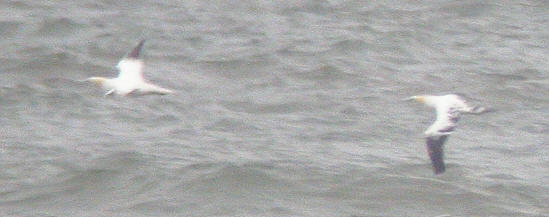 |
|
Gannet
- Ness Point - August 25, 2003 - 1.5km offshore - ©Andrew
Easton
|
CORMORANT Phalacrocorax carbo
Kessingland - 1st (5 S), 5th (1 S), 6th (2 S), 8th (1 S), 9th
(2 S), 11th (2 N, 1 S), 12th (1 S), 13th (1 S), 15th (1 N, 4 S), 16th
(1 S), 17th (1 N), 18th (4 N, 2 S), 19th (1 S), 21st (1 N, 2 S), 22nd
(2 S), 23rd (1 N, 2 S), 24th (4 N, 2 S), 25th (1 N), 26th (4 N, 2 S),
30th (1 N, 3 S), 31st (1 N, 3 S).
Lowestoft - 3rd (2 S), 10th (1 colour-ringed), 28th (2 in
harbour), 30th & 31st (1 colour ringed). The bird on the
10th, 30th and 31st involved a returning Dutch colour ringed bird.
LITTLE EGRET Egretta garzetta
At Ness Point three flew north together on the 30th. another had flown
south past Kessingland at 18:20 on the 21st (seen by a visiting Lizard
as the owner was eating tea!!!).
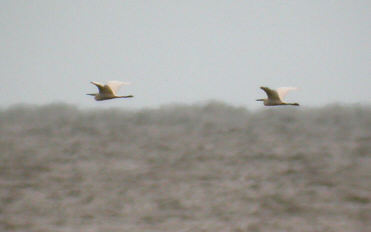 |
|
Little
Egrets - Ness Point - August 30th, 2003 - ©Tim Brown
(the third one was just out of shot!!!) |
GREY
HERON Ardea cinerea
Singles flew north at Ness Point on the 18th, south past Kessingland
on the 20th and south past Ness Point on the 25th.
EGYPTIAN GOOSE Alopochen aegyptiacus
One flew south past Kessingland on the 9th.
SHELDUCK Tadorna tadorna
Kessingland - on the 31st (9 N, 1 S).
WIGEON Anas penelope
Kessingland - 25th (1 N).
Ness Point - 25th (2 N), 30th (5 N).
TEAL Anas crecca
Kessingland - 5th (8 S), 6th (27 S), 10th (3 S),
11th (2 N, 8 S), 13th (5 S), 16th (8 N), 17th (71 S), 18th (108 S),
19th (12 S), 23rd (1 N), 24th (8 S), 25th (7 N, 118 S), 26th (60 S),
27th (2 S), 28th (2 S), 30th (5 S), 31st (19 S).
Lowestoft - 11th (3 S), 18th (150 S), 24th (2 S), 25th (52
N, 72 S), 30th (18 S), 31st (12 N, 10 S).
Corton - 23rd (1 N), 27th (7 o.s), 28th (2 S).
MALLARD Anas platyrhynchos
Ness Point - 25th (1 N).
EIDER Somateria mollissima
A female was present in Lowestoft Harbour on the 10th.
Kessingland - 5th (1 N), 7th (1 N).
COMMON SCOTER Melanitta nigra
Kessingland - 1st (31 N, 28 S), 2nd (9 N), 3rd (11 N), 4th
(2 N), 5th (8 N), 6th (2 N, 11 S), 7th (1 N, 10 S), 8th (4 S, 3o/s),
9th (3 N), 11th (4 S), 13th (15 N), 16th (1 N), 17th (12 S), 18th (4
N, 47 S), 19th (11 N, 5 S), 20th (4 N, 5 o.s.), 22nd (3 N), 23rd (1
N, 10 o.s.), 24th (3 N), 25th (11 N, 17 S, 17 o.s.),
26th (8 N, 32 S), 27th (3 N, 3 S, 10 o.s.), 28th (3 N, 1 S, 10 o.s.),
29th (3 N, 1 S), 30th (7 S), 31st (3 N).
Ness Point - 2nd (3 S), 18th (30 S), 24th (6 N), 25th
(19N, 25 S), 28th (3 N), 30th (10 N), 31st (13 N).
Corton - 23rd (1 N), 24th (6 N, 6 S), 27th (5 N).
VELVET SCOTER Melanitta fusca
Ness Point - 25th (2 S).
MARSH HARRIER Circus aeruginosus
A juvenile arrive in off the sea at Corton early morning on the
14th. Another juvenile arrived in off the sea at Kessingland early morning
on the 31st.
HOBBY Falco subbuteo
Corton - Noted over Corton sewage works on the 3rd and
27th, and west over Corton Church on the 16th.
Waveney Forest - 9th (1).
Kessingland - 18th (1 N), 22nd (1 S), 29th (1 S chasing
a small wader), 31st (1 hunting overhead).
OYSTERCATCHER Haematopus ostralegus
Kessingland - 1st (3 S), 3rd (1 N, 5 S), 4th (3 N, 5 S), 5th
(3 S), 6th (2 N, 27 S), 8th (10 N, 9 S), 9th (2 S), 11th (1 N, 4 S),
12th (1 S), 13th (2 N), 14th (1 N), 15th (17 N, 4 S), 16th (5 N, 3 S),
17th (3 S), 18th (6 N, 2 S), 19th (1 N, 1 S), 22nd (1 S), 23rd (2 N),
24th (2 N, 3S ), 26th (2 S), 27th (5 N), 28th (7 N, 2 S), 30th (2 N),
31st (5 N, 2 S).
Ness Point - 24th (3 S), 25th (10 N, 5 S), 30th (5 S),
31st (5 N).
Corton - 23rd (3 S), 24th (11 N, 5 S).
DOTTEREL Charadrius morinellus
A very smart, and typically confiding, juvenile was present on Kessingland
Beach throughout the day on the 31st.
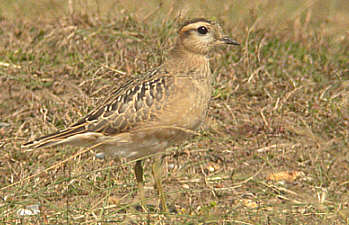 |
|
Juvenile
Dotterel - Kessingland - 31st August, 2003 - © Andrew Easton
|
GOLDEN PLOVER Pluvialis apricaria
Corton - 3rd (5 W over sewage works), 18th (1 S), 24th
(5 N).
Ness Point - 25th (3 N).
Nocturnal migrants were heard over Lowestoft on the 22nd and 23rd.
GREY PLOVER Pluvialis squatarola
Kessingland - 1st (4 S), 3rd (2 S), 5th (1 S), 8th (3 N),
18th (1 S), 29th (4 N), 30th (1 N).
Ness Point - 13th (1 S), 18th (1 S), 29th (1 N), 20th
(1 N).
Corton - 24th (5 N).
LAPWING Vanellus vanellus
One flew south past Kessingland on the 9th, and four arrived in
off the sea at Ness Point on the 18th and continued westwards.
KNOT Calidris canutus
Kessingland - 1st (1 S), 11th (1 S).
Lowestoft - 2nd (1 S), 25th (5 N, 1 S), 30th (6 N), 31st
(10 N, 9 S).
Corton - 28th (9 S)
SANDERLING Calidris alba
Ness Point - 25th (15 N).
Lowestoft - Three were on the beach at Pakefield on the
31st.
DUNLIN Calidris alpina
Kessingland - 1st (12 S), 8th (2 N), 10th (1 S), 22nd (4 S),
23rd (2 S), 25th (5 N).
Lowestoft North Beach - Seawatching on the 3rd produced
the bird pictured below walking south 5 metres in front of us!!!, 11th
(3 S), 13th (7 S), 25th (3 N, 3 S).
Hamilton Dock - 15th (2)
Corton - 24th (4 S).
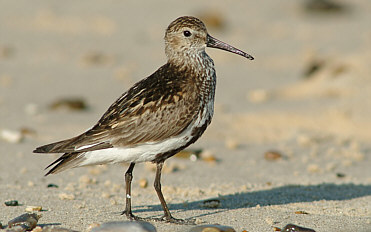 |
|
Dunlin
- Lowestoft North Beach - ©Robert Wincup
|
PURPLE SANDPIPER Calidris maritima
One flew north past Corton on the 24th. Two flew south past Ness Point on the 25th, and one was feeding on the rocks there later on the same day.
LITTLE STINT Caladris minuta
One flew north past Ness Point on the 23rd, with another north past Pakefield on the 31st.
RUFF Philomachus pugnax
One flew south at Gunton on the 25th.
Two flew south past Kessingland on the 31st.
CURLEW Numenius arquata
Kessingland - 1st (4 S), 3rd (1 S), 4th (1 S), 6th (2 S), 8th (1 S), 10th (1 S), 11th (1 N), 15th (2 N), 22nd (5 S), 23rd (1 N), 24th (2 S), 29th (1 S).
Ness Point - 3rd (1 S).
Corton - 23rd (4 S).
WHIMBREL Numenius phaeopus
Kessingland - 1st (1 S), 2nd (1 S), 3rd (1 S), 10th (1 S), 14th
(1 N), 16th (3 S), 21st (2 S), 22nd (2 S), 23rd (6 S), 24th (4 S), 25th
(3 S), 26th (1 S), 27th (1 S).
Ness Point - 2nd (2 S), 21st (9 S), 24th (1 N).
Corton - 24th (7 S), 25th (2 S), 28th (1 S).
Gunton - 25th (4 S), 26th (1).
COMMON SNIPE Gallinago gallinago
Two flew in from off the sea at Pakefield on the 31st.
BLACK-TAILED GODWIT Limosa limosa
Kessingland - 18th (5 S).
Lowestoft - 31st (2 S with Redshanks).
BAR-TAILED GODWIT Limosa lapponica
Kessingland - 1st (1 S), 8th (3 N), 11th (1 S), 29th (1 N).
Corton - 14th (1 N).
Ness Point - 30th (1 N).
REDSHANK Tringa totanus
Kessingland - 14th (15 S), 17th (3 S), 19th (39 S), 20th
(2 S), 21st (6 S), 22nd (9 S), 23rd (109 S), 27th (2 S), 30th (9 S).
Ness Point - 25th (2 S), 30th (9 S), 31st (1 N, 22 S).
Gunton - 28th (8 S).
GREENSHANK Tringa nebularia
Corton - 16th (1 N).
Gunton - 26th (1).
Ness Point - 28th (1 N).
Pakefield - 31st (1 in off sea then west inland).
COMMON SANDPIPER Actitis hypoleucos
Noted at Lound and Hamilton Dock on the 10th. One was again in Hamilton
Dock on the 15th.
One was on groynes along the beach north of Corton on the 16th.
Three were along the groynes at Corton Cliffs on the 23rd and 24th.
A flock of eight flew south past Ness Point on the 25th.
Three were on the River Hundred at Kessingland on the 25th.
TURNSTONE
Arenaria interpres
Kessingland - 1st (4 S), 19th (9 S), 22nd (3 S).
Lowestoft North Beach - 2nd (4 S), 3rd (6 S), 13th (10),
20th (2), 22nd (11).
Hamilton Dock - 15th (10).
Lowestoft South Beach - 27th (5), 28th (1).
Corton - 28th (1 S).
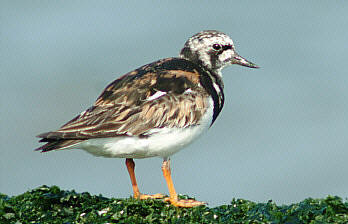 |
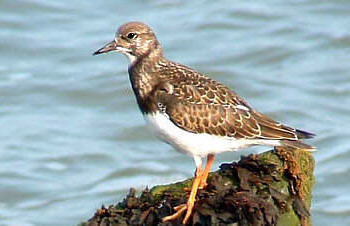 |
|
Turnstone
- Lowestoft North Beach (adult top) ©Robert Wincup and Ness
Point (juvenile below) ©David Palmer
|
POMARINE
SKUA Stercorarius pomarinus
Lowestoft North Beach - 3rd (1 S @ 18:10 approx 6
km offshore).
Corton - 23rd (1 N mid-day).
Ness Point - 30th (1 juv. N), 31st (1 N).
Kessingland - One flew north at 07:00 on the 1st about
1 kilometre from the beach. The visibility was poor in heavy rain but
the jizz was unmistakable. What was almost certainly the same individual
returned south at 07:28 and after a brief skirmish with an unidentified
gull settled on the sea. At 9:35 on the 12th one flew south past Kessingland,
at 9:50 it returned and attacked a Common Tern as it flew north about
300 metres from the beach.
23rd - a dark phase bird was lingering offshore before flying south,
and probably the same bird was there again on the 24th.
26th - a dark phase bird flew north at 8:58. It successfully attacked
a Kittiwake, taking the offering in the air before settling on the sea.
28th - at 14:05 an immature flew north attacking in quick succession
a Great Blacked Gull, Herring Gull and Kittiwake, all without success.
29th - at 19:20 one was lingering off the beach.
30th - an immature was noted off Kessingland Beach, attacking gulls
and terns before flying slowly north at 07:10.
31st - 6 sightings were made off Kessingland. All were dark type, 3
flying north and 3 lingering off the beach at various times of the day.
ARCTIC SKUA Stercorarius parasiticus
Kessingland - 1st (1 N pale, 1 o.s dark), 2nd (5 N, 3 pale,
2 dark), 3rd (2 N, 1 pale, 1 dark), 5th (1 N, 1 o.s both pale), 6th
(1 N, 1 o.s both pale), 7th (1 N dark), 8th (4 N, 3 dark, 1 pale), 10th
(2 N, a pale and a dark phase flew north together past Kessingland),
12th (2 N, both pale), 13th (4 N, 2 pale 2 dark, 1 S distant), 15th
(3 N, 2 dark 1 pale, 2 S both dark), 15th (3 N, 2 dark, 1 pale, 2 S
both dark), 16th (1 dark attacking terns), 17th (5 N, 4 dark, 1 pale,
1 S dark), 18th (1 N pale), 19th (1 N dark), 20th (2 N, 1 pale 1 dark,
1 attacking terns pale), 22nd (1 S then on sea dark), 23rd (3 N 1 dark
2 pale, 2 S 1 pale 1 dark), 24th (1 N dark), 25th (2 N, 1 dark 1 int.,
1 S dark), 27th (1 N pale, 1 S dark), 29th (1 N dark, 1 S dark, 1 lingering
off the beach, dark. These were probably three different individuals),
31st 17 sightings of were made. All but one were dark type, with 12
N, 2 S and 3 lingering at various times during the day.
NOTE: The total of five seen on the 2nd does not include
an additional group of three that passed through together during a tea
making ceremony for visiting Lizards!!!
Ness Point - 3rd (2 N together, both cracking pale phase adults),
5th (dark phase N successfully robbing both a tern sp. and a Herring
Gull of their tea!), 13th (1 chasing terns, then north), 17th, 18th
(4 N), 20th (2 N), 21st (2 S), 25th (1 N, 4 S), 30th (3 N, 5 S), 31st
(8 N, but many lingering well offshore).
Corton - 7th (1 chasing terns was possibly the same at the bird
seen off Lowestoft North Beach on the 5th), 11th (1 N), 14th (2 N),
15th (2 S), 16th (1 S), 23rd (4 2 pale phase, 2 dark phase milling around
all day chasing terns and gulls offshore), 24th (5-8), 27th (c5 individuals
including at least 3 lingering chasing terns), 28th (3 N).
LONG-TAILED SKUA Stercorarius longicaudus
It's certainly been a brilliant first half of the month for skuas This
species is without doubt the most elegant and most sought after!!!
One flew south at Corton at 10:49 on the 15th in the company of two
Arctic's. A short while later it flew back north and was in view for
15 minutes offshore.
Further south at Kessingland a probable flew south at 17:55.
One flew south past Corton on the afternoon of the 24th.
On the 27th one flew north past Kessingland at 9:40 before being seen
from Corton at 10:05.
One flew north past Pakefield on the 31st and was also seen by observers
at Ness Point.
At 7:05 on the 31st one flew north past Kessingland about 2 kilometres
from the beach.
GREAT SKUA Catharacta skua
Kessingland - 2nd (1 N @ 06:35 approximately 1.5 kilometres
offshore), 4th (1 N @ 13:30 almost over the very crowded beach, most
impressive!!!), 7th (1 N @ 14:37 c100m offshore), 8th (1 N @ 08:45 attacking
a juv. Gannet forcing it onto the sea before continuing north), 18th
(1 N @ 9:08), 21st (1 N @ 17:50), 22nd (1 N @ 7:12), 23rd (1 N @10:10),
25th ( 2 N @7:05, 1 N @ 10:23), 26th (1 N @ 13:48), 29th (1 N @ 9:02).
Lowestoft - 17th (1 N), 24th (3 N), 25th (1 N).
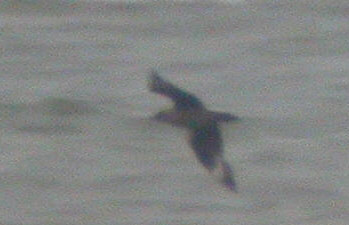 |
|
Great
Skua - Ness Point - August 25, 2003 - 1.5km offshore - ©Andrew
Easton
|
MEDITERRANEAN
GULL Larus melanocephalus
Lowestoft Harbour - 21st (ad + 2nd sum), 23rd (ad), 27th (2nd-winter
+ ad), 28th (1), 30th & 31st (1 2nd winter.).
Corton - 23rd (ad S), 24th (ad S).
Ness Point - 28th ( 1 S).
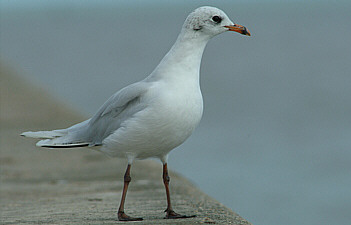 |
|
Mediterranean
Gull - Lowestoft South Pier - ©Robert Wincup
|
LITTLE
GULL Larus minutus
Kessingland
- 1st (1 N, 1 S), 2nd (10 N, 8 S, 3 o.s), 3rd (9 N, 1 S), 4th (9 N,
7 S), 5th (9 N, 2 S, 1 o/s), 6th (13 N, 7 S), 7th (63 N, 24 S), 8th
(14 N, 13 S, 2 feeding), 9th (3 N, 16 S), 10th (9 N, 10 S), 11th (1
N, 4 S), 12th (1 S), 13th (10 N, 3 S), 14th (1 S), 15th (5 N, 1 S),
16th (4 N, 1 S), 17th (1 N, 4 S), 18th (3 S, 2 feeding), 19th (1 N,
3 S), 20th (1 N, 2 S), 21st (1 N), 22nd (1 N), 23rd (3 N, 5 S), 24th
(1 N, 1 S), 26th (1 N, 4 S), 27th (1 S), 31st (2 N).
Lowestoft North Denes Oval - Good numbers of these charismatic
gulls continue to keep us entertained in Lowestoft. During the day and
early evening they frequent the groynes along the north beach as well
as mill around on the groynes. Recently pre-roost gatherings have formed
on the Denes Oval cricket pitch. On the 3rd (59), 10th (9).
Lowestoft North Beach - 3rd (36), 4th (10), 5th (12),
9th (4).
Corton - 23rd (2 ad's), 30th (2 N).
Ness Point - 25th (2 N), 31st (1 N).
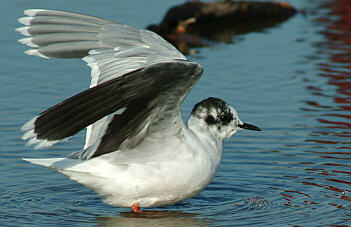 |
|
Little Gull - Links Road Car Park - ©Robert Wincup
|
SABINE'S
GULL Larus sabini
Still present around Lowestoft Harbour and South Pier on the 26th,
having now notched up an 11 week stay. It now sports a winter plumage
black 'skull cap' with a vestige of the black collar on the rear of
the neck. Apparently no sign of it since the 26th despite searching.
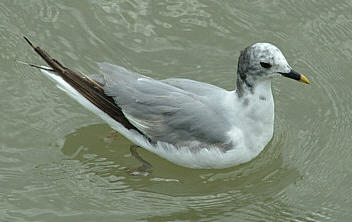 |
|
Sabine's
Gull - Lowestoft South Pier - ©Robert Wincup
|
YELLOW-LEGGED
GULL Larus michahellis
Seven up! Looking as tatty as ever the returning adult has appeared
for its seventh consecutive summer. On the 3rd it was drifting over
Lowestoft North Denes apparently looking for scraps left by campers.
On the 4th and 13th it was roosting on the Birds Eye Roof near Ness
Point. On the 15th and 21st it was on the groynes along the North Beach.
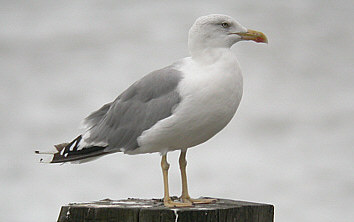 |
|
Yellow-legged Gull - Lowestoft North Beach - ©Robert Wincup
|
KITTIWAKE
Rissa tridactyla
Kessingland - 1st (4 N, 5 S), 2nd (17 N, 18 S), 3rd (7 N, 4
S), 4th (14 N, 5 S), 5th (16 N, 5 S), 6th (4 N, 9 S), 7th (4 N, 1 S),
8th (5 N, 1 S), 9th (5 N), 10th (1 N, 5 S), 11th (2 N), 12th (6 N),
13th (3 N, 9 S), 14th (1 N, 5 S), 15th (13 N, 5 S), 16th (7 N), 17th
(14 N, 4 S), 18th (5 N), 19th (2 N), 20th (4 N, 3 S), 21st (7 N),
22nd (1 N, 2 S), 23rd (25 N, 22 S), 24th (4 N, 3 S), 25th (3 N), 26th
(12 N), 27th (8 N), 28th (5 N, 1 S), 29th (8 N, 1 S), 30th (9 N, 1 S),
31st (4 N).
SANDWICH
TERN Sterna sandvichensis
Kessingland - 1st (5 N, 67 S), 2nd (10 N, 22 S), 3rd (14 N,
13 S, 15 feeding), 4th (15 N, 16 S, 10 feeding), 5th (8 N, 39 S, 3 feeding),
6th (11 N, 29 S), 7th (4 N, 17 S), 8th (19 N, 49 S), 9th (1 N, 15 S,
2 feeding), 10th (5 S, 5 feeding), 11th (1 N, 12 S), 12th (1 N, 12 S),
13th (3 N, 17 S), 15th (2 N, 6 S), 16th (1 N, 5 S, 2 feeding), 17th
(5 N, 4 S), 18th (5 N, 11 S, 2 feeding), 19th (1 N, 3 S), 20th (2 N,
8 S), 21st (2 N, 12 S), 22nd (2 N, 11 S), 23rd (4 N, 23 S), 24th (7
N, 5 S), 25th (10 S, 4 feeding), 26th (3 feeding), 27th (10 S, 2 feeding),
28th (10 feeding), 29th (3 feeding), 30th (5 feeding), 31st (25-35 feeding).
Ness Point - 3rd (17 S), 4th (2 on groynes), 30th (10
N).
COMMON TERN Sterna hirundo
Kessingland - 1st (34 N, 298 S), 2nd (49 N, 285 S), 3rd (16
N, 60 S, 25 feeding), 4th (84 N, 161 S, 20 feeding), 5th (43 N, 149
S, 25 feeding), 6th (39 N, 97 S, 20 feeding), 7th (10 N, 82 S, 20 feeding),
8th (57 N, 125 S, 25 feeding), 9th (6 N, 111 S, 25 feeding), 10th (8
N, 91 S, 10 feeding), 11th (52 N, 21 S, 5 feeding), 12th (26 N, 22 S),
13th (31 N, 49 S, 5 feeding), 14th (5 N, 26 S, 10 feeding), 15th (31
N, 5 S), 16th (18 N, 21 S), 17th (16 N, 11 S, 10 feeding), 18th (35
N, 79 S, 10 feeding), 19th (32 N, 81 S), 20th (4 N, 20 S), 21st (11
N, 20 S, 15 feeding), 22nd (10 N, 37 S, 20 feeding), 23rd (8 N, 59 S,
10 feeding), 24th (17 N, 22 S), 25th (33 S, 30 feeding), 26th (20 S,
30 feeding), 27th (20 feeding), 28th (10 S, 15 feeding), 29th (30 S,
20 feeding), 30th (12 feeding), 31st (50+ feeding).
Lowestoft North Beach - Good numbers continue to be seen
as adults bring food to the chicks that wait patiently on the groynes.
ARCTIC TERN Sterna paradisaea
Continuing the run of scarce terns an adult was at Ness Point on the
4th.
LITTLE TERN Sterna albifrons
Kessingland - 1st (11 S), 2nd (14 N, 8 S), 3rd (2 N, 18 S),
4th 33 N, 28 S), 5th (57 N, 52 S), 6th (28 N, 31 S), 7th (8 N, 30 S,
15 feeding), 8th (6 N, 26 S), 9th (1 N, 90 S, 30 feeding), 10th (11
N, 26 S, 25 feeding), 11th (41 N, 15 S, 25 feeding), 12th (52 N, 8 S),
13th (19 N, 39 S, 6 feeding), 14th (20 N, 22 S, 10 feeding), 15th (18
N, 13 S), 16th (12 N, 6 S, 20 feeding), 17th (30 feeding), 18th (1 N,
3 S, 34 feeding), 19th (8 N, 12 S, 8 feeding), 20th (8 N, 1 S, 20 feeding),
21st (25 feeding), 22nd (15 feeding), 23rd (4 feeding), 24th (8 feeding),
25th (5 feeding), 26th (1 feeding), 28th (1 S), 29th (1 feeding), 30th
(2 feeding), 31st (1 S).
Lowestoft - 4th (19 N), 24th (8 N).
Corton - 23rd (1 S).
BLACK TERN Chlidonias niger
Kessingland - looking like paper boats with their tails
and wings pointing upwards a group of eight drifted south on the sea
at 14:25 on the 4th.
Lowestoft North Beach - 2nd (moulting adult on groynes).
Ness Point - 18th (1 S).
Corton - 7th (1 S), 11th (1 N).
GUILLEMOT Uria aalge
Ness Point - 17th (2 south on sea), 26th (1 south on sea), 28th
(1 S).
PUFFIN Fratercula arctica
One flying south well offshore past Ness Point on the 31st was quite
a surprise for the observers.
AUK sp. Alcidae
Ness Point - 24th (1 N), 25th (1 N).
SWIFT Apus apus
One was hawking insects over Kessingland on the 31st.
MEADOW PIPIT Anthus pratensis
Two flocks totalling 27 arrived in off the sea at Corton on the
afternoon of the 24th.
YELLOW WAGTAIL Motacilla flava
Corton - 18th (1 S).
GREY WAGTAIL Motacilla
cinerea
One flew south at Gunton on the 26th.
NORTHERN WHEATEAR Oenanthe oenanthe
The first of the autumn, an immature bird flew north along Lowestoft
North Beach on the 3rd thereafter at:
Lowestoft North Denes - 13th (1), 25th (1), 28th (1),
29th (1).
Kessingland Beach - 16th (2), 31st (1).
Corton - 23rd (1), 24th (1), 25th (3).
Gunton - 25th (7), 26th (1).
Ness Point - 25th (3), 26th (2).
Kirkley Cemetery - 25th (1).
Lowestoft Cemetery - 28th (1).
WHINCHAT Saxicola rubetra
The first of the autumn was along Gunton disused railtrack on the 18th,
another was at Corton Sewage Works on the 24th. On the 25th the species
was noted as follows Gunton (5), Corton (2), Harris Avenue, Lowestoft
(1).
Gunton Dunes - 28th (1).
Kessingland - 31st (1).
COMMON REDSTART Phoenicuros phoenicuros
Three were seen on the 25th, one at Dip Farm, Gunton, and two together
along the disused railway line at Corton.
LESSER WHITETHROAT Sylvia curruca
One was along Gunton disused railway track on the 12th and 18th.
Further north at Corton three were present on the 18th. Singles were
along the disused railway tracks at Gunton and Corton on the 25th, with
four at Gunton on the 26th.
GARDEN WARBLER Sylvia borin
Three were along Corton disused railway line on the 26th with two
present on the 27th and 28th.
WILLOW WARBLER Phylloscopus trochilus
Three migrants were at Corton on the 7th and 23rd (1). Further inland
two family parties were at Herringfleet Hills on the 9th.
GREENISH WARBLER Phylloscopus trochiloides viridanus
The elusive first winter found on the 25th was again present in
the shelter belt along the Corton Road edge of Dip Farm Football Pitch
throughout the 26th. It was even heard to sing briefly (the 1986 individual
in Belle Vue Park would also sing occasionally). This largely silent
individual ranges between the football pitch car park and just north
of the fence between the football pitch and golf course. On occasions
it accompanied a roving Tit flock that passed through.
Much like the Siberian Chiffchaff earlier in the year its appearance
changed dramatically depending on the light. However, in our opinion
it looked like a typical Greenish Warbler when ever we had good views.
It's not "JUST" a Greenish Warbler though, it's a sensational
bird and strong candidate for our bird of the year.
Being only the third record in our area, the last being in May 1993,
it was a first for many of the younger Lizards.
SPOTTED FLYCATCHER Muscicapa striata
A family party were noted in Waveney Forest on the 16th. On the
25th three were at Gunton Hall and one was at Dip Farm Football Field,
Gunton on the 25th and 26th.
PIED FLYCATCHER Ficedula hypoleuca
Singles noted along Gunton disused railway track on the 12th and 18th.
Two were along the disused railway line at Corton on the 24th.
On the 25th at least 22 were located:
Belle Vue Park - (2).
Gunton Warren - (1).
Gunton Hall - (3).
Dip Farm, Gunton - (4).
Corton Woods - (2).
Corton Disused Railway - (1), 27th (1).
Hopton Disused Railway - (9).
Lowestoft Cemetery - 28th (1).
We wonder how many more went undetected.
NUTHATCH Sitta europaea
This species has turned into an extremely difficult bird in Lowestoft
in recent years. One at Gunton Hall was the first record for a long,
long time.
HOUSE SPARROW Passer domesticus
A sizable flock of 60+ were at the old sewage works site at Corton Cliffs
on the 4th, 7th and 23rd.
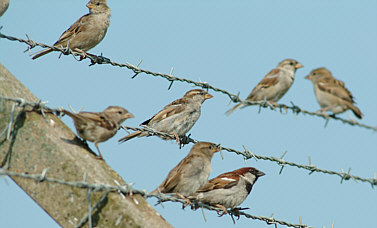 |
|
House
Sparrows - Corton Cliffs - August 4, 2003 - ©Robert Wincup
|
BULLFINCH Pyrrhula pyrrhula
One was at Herringfleet Hills on the 9th.
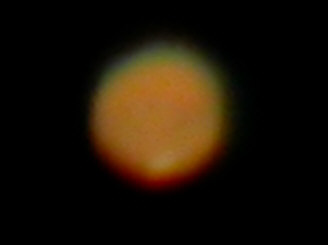
|
|
Mars
©Andrew Easton
|
| With
the planet Mars making one of it's closest approaches to Earth for
over 60 000 years on the morning of August 27, the opportunity was
taken to digiscope it on the 24th. The white spot of the South Polar ice cap was just visible using a telescope. However, when magnified by the cameras' zoom the results were pleasantly surprising. As well as the ice cap the darker greyish markings in the southern hemisphere were also visible. |